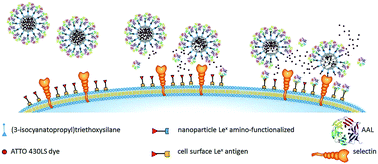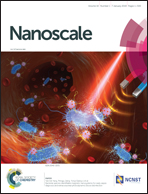Lectin-gated and glycan functionalized mesoporous silica nanocontainers for targeting cancer cells overexpressing Lewis X antigen†
Abstract
Gated mesoporous silica nanoparticles can deliver payload upon the application of a predefined stimulus, and therefore are promising drug delivery systems. Despite their important role, relatively low emphasis has been placed on the design of gating systems that actively target carbohydrate tumor cell membrane receptors. We describe herein a new Lewis X (Lex) antigen-targeted delivery system comprising mesoporous silica nanoparticles (MSNs) loaded with ATTO 430LS dye, functionalized with a Lex derivative (1) and capped with a fucose-specific carbohydrate-binding protein (Aleuria aurantia lectin (AAL)). This design takes advantage of the affinity of AAL for Lex overexpressed receptors in certain cancer cells. In the proximity of the cells, AAL is detached from MSNs to bind Lex, and selectins in the cells bind Lex in the gated MSNs, thereby inducing cargo delivery. Gated MSNs are nontoxic to colon cancer DLD-1 cells, and ATTO 430LS dye delivered correlated with the amount of Lex antigen overexpressed at the DLD-1 cell surface. This is one of the few examples of MSNs using biologically relevant glycans for both capping (via interaction with AAL) and targeting (via interaction with overexpressed Lex at the cell membrane).



 Please wait while we load your content...
Please wait while we load your content...